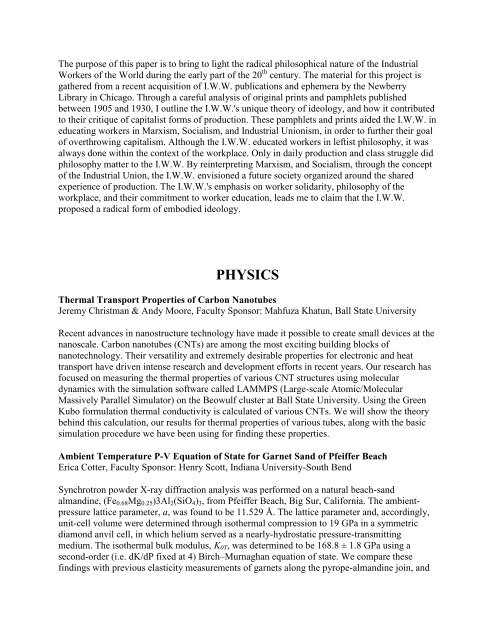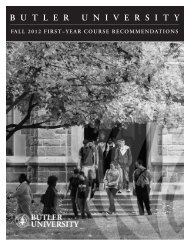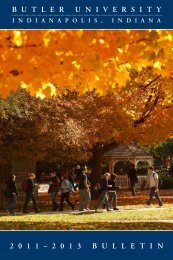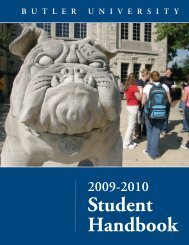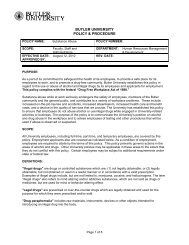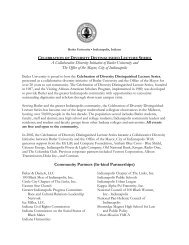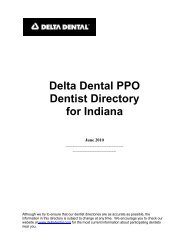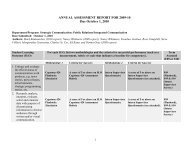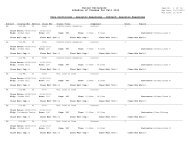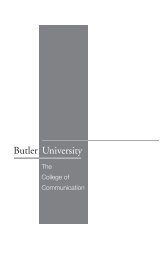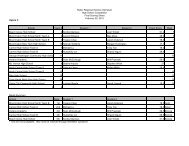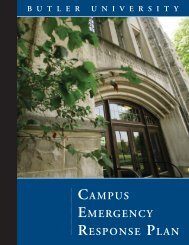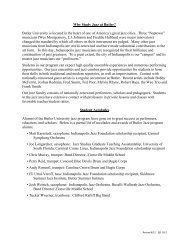Anthropology - Butler University
Anthropology - Butler University
Anthropology - Butler University
You also want an ePaper? Increase the reach of your titles
YUMPU automatically turns print PDFs into web optimized ePapers that Google loves.
The purpose of this paper is to bring to light the radical philosophical nature of the Industrial<br />
Workers of the World during the early part of the 20 th century. The material for this project is<br />
gathered from a recent acquisition of I.W.W. publications and ephemera by the Newberry<br />
Library in Chicago. Through a careful analysis of original prints and pamphlets published<br />
between 1905 and 1930, I outline the I.W.W.'s unique theory of ideology, and how it contributed<br />
to their critique of capitalist forms of production. These pamphlets and prints aided the I.W.W. in<br />
educating workers in Marxism, Socialism, and Industrial Unionism, in order to further their goal<br />
of overthrowing capitalism. Although the I.W.W. educated workers in leftist philosophy, it was<br />
always done within the context of the workplace. Only in daily production and class struggle did<br />
philosophy matter to the I.W.W. By reinterpreting Marxism, and Socialism, through the concept<br />
of the Industrial Union, the I.W.W. envisioned a future society organized around the shared<br />
experience of production. The I.W.W.'s emphasis on worker solidarity, philosophy of the<br />
workplace, and their commitment to worker education, leads me to claim that the I.W.W.<br />
proposed a radical form of embodied ideology.<br />
PHYSICS<br />
Thermal Transport Properties of Carbon Nanotubes<br />
Jeremy Christman & Andy Moore, Faculty Sponsor: Mahfuza Khatun, Ball State <strong>University</strong><br />
Recent advances in nanostructure technology have made it possible to create small devices at the<br />
nanoscale. Carbon nanotubes (CNTs) are among the most exciting building blocks of<br />
nanotechnology. Their versatility and extremely desirable properties for electronic and heat<br />
transport have driven intense research and development efforts in recent years. Our research has<br />
focused on measuring the thermal properties of various CNT structures using molecular<br />
dynamics with the simulation software called LAMMPS (Large-scale Atomic/Molecular<br />
Massively Parallel Simulator) on the Beowulf cluster at Ball State <strong>University</strong>. Using the Green<br />
Kubo formulation thermal conductivity is calculated of various CNTs. We will show the theory<br />
behind this calculation, our results for thermal properties of various tubes, along with the basic<br />
simulation procedure we have been using for finding these properties.<br />
Ambient Temperature P-V Equation of State for Garnet Sand of Pfeiffer Beach<br />
Erica Cotter, Faculty Sponsor: Henry Scott, Indiana <strong>University</strong>-South Bend<br />
Synchrotron powder X-ray diffraction analysis was performed on a natural beach-sand<br />
almandine, (Fe 0.68 Mg 0.25 )3Al 2 (SiO 4 ) 3 , from Pfeiffer Beach, Big Sur, California. The ambientpressure<br />
lattice parameter, a, was found to be 11.529 Å. The lattice parameter and, accordingly,<br />
unit-cell volume were determined through isothermal compression to 19 GPa in a symmetric<br />
diamond anvil cell, in which helium served as a nearly-hydrostatic pressure-transmitting<br />
medium. The isothermal bulk modulus, K 0T , was determined to be 168.8 ± 1.8 GPa using a<br />
second-order (i.e. dK/dP fixed at 4) Birch–Murnaghan equation of state. We compare these<br />
findings with previous elasticity measurements of garnets along the pyrope-almandine join, and


